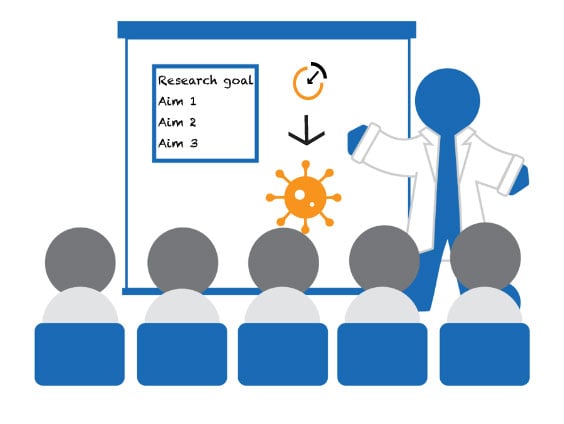This post was contributed by Erik Snapp, the Director of Student and Postdoctoral Programs at the
Janelia Research Campus of the Howard Hughes Medical Institute.
Are you currently on or planning to go on the academic job market? In addition to all of the documents you submit, you will need to present a "chalk talk." However, few, if any, faculty job candidates have seen an actual chalk talk. Their first exposure to a chalk talk is usually their own. This is a problem. The chalk talk is effectively a million dollar sales pitch. Given this large sum, one might expect that applicants would work for months to hone a chalk talk. Yet, I often hear, "I have an interview next week and it includes a chalk talk. What should I include in my chalk talk?"
So what exactly is a chalk talk? On the surface, a chalk talk is quite simple. It's you, a dry erase board, some markers (chalk is rare these days), and a room of 5-30 faculty members. The session lasts up to an hour. You will get 5-10 minutes to present your research vision uninterrupted and then you will begin working through your aims over the next 45 minutes. The faculty will ask you lots of questions. Your task is to convince them to accept you as a colleague and give you a million dollar startup package.
There are three steps to chalk talk preparation:
- Define your research vision.
- Organize your vision into a chalk talk format.
- Practice.
 Define your research vision
Define your research vision
A chalk talk could be your plans for your first NIH R01 grant proposal or a 10-year research plan. I suggest preparing for both types. Your research vision is your approach to resolving a significant knowledge gap in your field or even creating a new field. A knowledge gap is an impediment to progress in a field. It is a mechanistic problem, a "how" question, not a vague goal or a "what" question. For example, "we want a better understanding of the Z pathway" is vague and "what proteins regulate the Z pathway?" is an open-ended list of proteins. Instead, consider "how do proteins X and Y regulate the Z pathway?"
A well-defined outcome makes it easier for the search committee to understand your goal, what you expect to find, and how you will interpret and use the information. In contrast, a list of experiments or a laundry list of molecules to screen has unclear utility. You cannot predict what will happen. Without the prediction, you have no hook. A battery of new assays for your screen result may or may not actually help. Ultimately, if you cannot describe the likely outcome with some specifics, the search committee member cannot either.
Therefore, you need to be able to describe experimental approaches in terms of the question, the methods, the tools or techniques that can help resolve the question, the anticipated outcomes, the alternative approaches, and what will you do if your model is correct or your data favor a different model. Finding evidence for or against a model is a standard scientific strategy. However, a robust research proposal will distinguish between competing models. Comparing model A vs. B is more constructive than testing the validity of a single model. The first approach can lead to new directions, while the second approach could terminate with the rejection of a model and no clear alternatives.
Typically, a research vision is broken up into three aims. Two or four aims are also acceptable. Aims should be mechanistic, doable by 1-3 people in 1-5 years, and contribute to resolving the overarching knowledge gap. Aims should have short titles, a clear easy-to-understand question/goal, an approach, anticipated outcomes, and preferably a description of the payoff if the aim is successful. Note that aims do not need to be grant aims. Each aim could be the basis of a single grant. Either way, think realistically about the time and resources required to feasibly accomplish the aims and clarify what type of aim you are describing. It's easy to be overly ambitious – a common mistake is to make each aim into a 10-year research program. It's a good idea to bounce your ideas off of senior faculty members who can help you identify overly ambitious goals and can help you distinguish mechanistic questions from open ended screens and data collection.
Organize your research vision into the chalk talk format
Once you have developed your research vision, you need to package it as a roughly 30 minute chalk talk. You will not necessarily get to present the whole 30 minute version because you will be interrupted frequently by committee members. As mentioned above, plan to give your 10 minute overview and address the aims in more depth in the remaining time. The typical chalk talk structure is:
- What is the big question or mystery that motivates your research? This is the central idea. It should be at a high level, broadly understandable to scientists outside your field, and interesting. For example, “there is a significant need for healthy livers for transplants. Growth of new livers in culture could resolve this shortage."
- What is the knowledge gap you plan to address and why is it significant? What is the problem you will study? Why this problem and why now? Narrow down your problem and then explain why it’s significant and innovative. For example, "while it is possible to grow liver stem cells and liver-like mini-organs or organoids, neither of these can substitute for a liver transplant. My lab will combine bioengineered scaffolds with patient stem cells to generate compatible functional livers.”
- Why are you the best person to do this research? Do you have innovative tools? A novel dataset? Unique expertise? A novel hypothesis? Part of the motivation for doing the research should be that you have the ability to execute the proposal and the tools/resources/technology exist to solve the problem.
- What will you have accomplished in 5-10 years? You need to be able to describe what success looks like. If you are successful, what will be learned and/or now be possible to do? Research accomplishments are remembered for the problem solved, not for the amount of data obtained.
- What is your proposed approach to resolve the knowledge gap? This includes the overview and the individual aims. Describe the question, the bare minimum of background needed to understand the problem and goal, the approach, anticipated outcome, and payoff for each aim. Learn to communicate your story with only the most salient details. Make the most of your limited speaking time.
Beyond the information you seek to convey in your chalk talk, there's the vital task of engaging your audience. You need to make your audience care, to want to know the answer to your research problem. Creating a coherent unified story and model can help make your ideas easier to understand and more exciting.
Practice presenting your chalk talk
Perfect your story and delivery. Design simple figures and diagrams to illustrate your vision. Practice drawing and writing everything in a form that is easily visible from the back of the room. Consider going beyond the whiteboard. You may wish to create a sculpture or print a 3D model to better illustrate your point.
Practice the full chalk talk with questions from the committee. For a list of common questions, check out this eBook about applying for faculty positions. You need to practice with faculty members that have served on search committees. If possible, do at least two full length practices (~1 h) and get feedback. It’s also helpful to practice at least a few times with people that are outside your lab and outside your field. If they can understand and are engaged by your presentation, then you’re on the right track. Furthermore, practice getting back to your story. Committee questions can derail your talk. You need to balance respectfully answering questions while steering the conversation back to your vision.
On the day of your chalk talk
- Bring your own fresh set of erasable markers. You’ll have the colors you want and you know they will work.
- Stabilize your blood sugar. Find an energy bar that you like and consider eating one before your chalk talk.
- Bring your own bottle of water.
- If possible, write down your short aims and project title on the board before or while the committee is arriving. Spend as much time as possible facing the committee and not the whiteboard.
- Thank everyone for the opportunity to share your research vision with them.
- Do not noticeably look at your watch.
- Be enthusiastic. This is your research program. You should be proud of it and be excited about getting the opportunity to realize your vision.
Many thanks to our guest blogger, Erik Snapp!
 Erik Lee Snapp received his PhD in Molecular Microbiology and Immunology from Oregon Health Sciences University, did his postdoctoral fellowship with Jennifer Lippincott-Schwartz at the National Institutes of Health, was an Associate Professor at Albert Einstein College of Medicine in the Department of Anatomy and Structural Biology, and now serves as the Director of Student and Postdoctoral Programs at the Janelia Research Campus of the Howard Hughes Medical Institute. His interests include the quality control of secretory proteins in the Endoplasmic Reticulum, optimization of fluorescent proteins, and live cell imaging approaches. Erik is also an avid long distance runner, gardener, cook, and outdoor photographer.
Erik Lee Snapp received his PhD in Molecular Microbiology and Immunology from Oregon Health Sciences University, did his postdoctoral fellowship with Jennifer Lippincott-Schwartz at the National Institutes of Health, was an Associate Professor at Albert Einstein College of Medicine in the Department of Anatomy and Structural Biology, and now serves as the Director of Student and Postdoctoral Programs at the Janelia Research Campus of the Howard Hughes Medical Institute. His interests include the quality control of secretory proteins in the Endoplasmic Reticulum, optimization of fluorescent proteins, and live cell imaging approaches. Erik is also an avid long distance runner, gardener, cook, and outdoor photographer.
Additional resources on the Addgene blog
- Find tips for presenting a science talk
- Check out our transferable skills guide
- Read all of our career blog posts
Resources on Addgene.org
- Learn more about careers at Addgene
- Watch our career videos
Topics: Science Careers, Applying for Jobs






Leave a Comment